A strong core is not just about looking good—it’s the foundation of true fitness for men.
It’s a complete system of muscles around your midsection that protects your spine, improves balance, and prevents injuries.
After testing countless routines, I’m convinced these exercises deliver the best results for men.
This guide covers essential core exercises you can do anywhere. Some require no equipment, while others require basic gym gear. All have been tested and proven effective.
Each exercise targets different parts of your core: Abs, obliques, and deep stabilizers (transverse abdominis).
To Know Your Body Fat %: Use Our Body Fat % Calculator
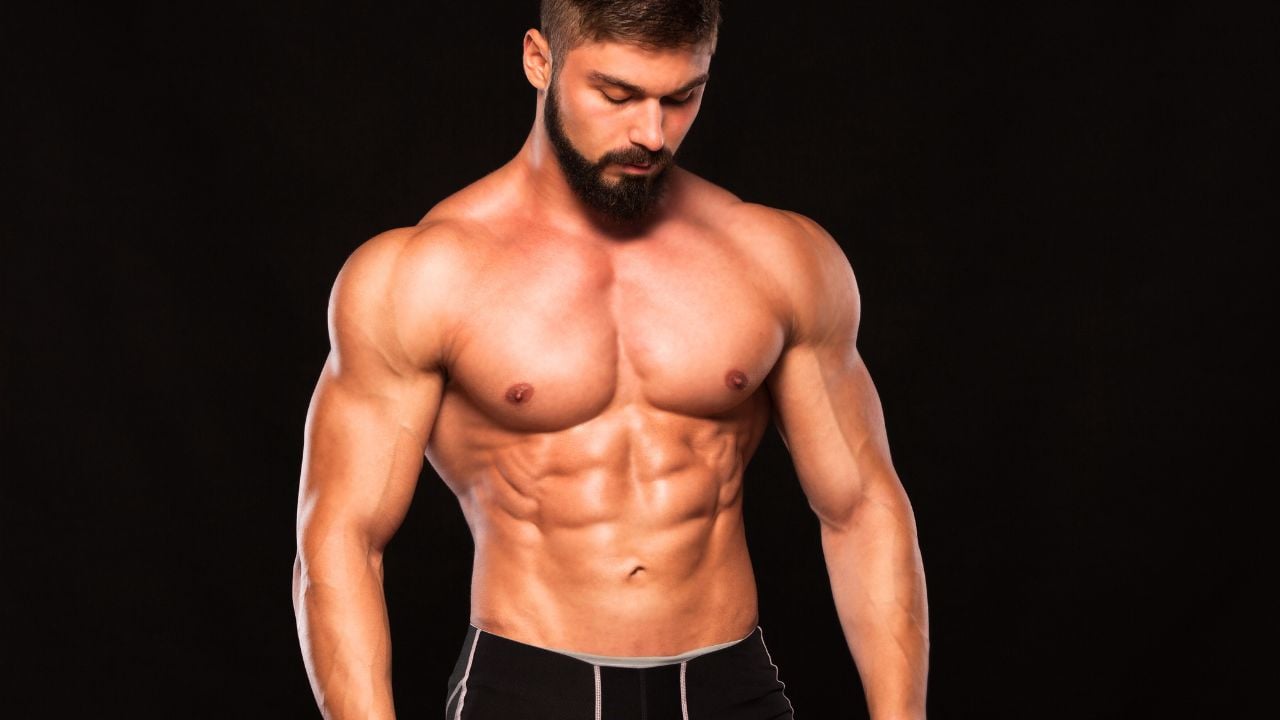
- 25 Best Core Strengthening Exercises for Men
- 1. Lying Straight Leg Raise
- 2. Plank
- 3. Side Plank
- 4. Dead Bug
- 5. Twisting Sit Up
- 6. Abs wheel rollout
- 7. Barbell rollout
- 8. Cross-Body Mountain Climber
- 9. Bird Dog
- 10. V-Up
- 11. Superman
- 12. Flat bench hyperextension
- 13. Good Morning Exercise
- 14. Hip Bridge
- 15. Pallof Press
- 16. Cable Wood Chop
- 17. Lying Bent-Knee Twist
- 18. Dumbbell Side Bend
- 19. Stability Ball Tuck
- 20. Side Plank Dips
- 21. Dumbbell Farmers Walk
- 22. Kettlebell Swing
- 23. Russian Twist
- 24. Turkish Get Up
- 25. Bicycle Crunch
- Core Strengthening Workout Plans
- Beginner Core Workout Plan
- Intermediate Core Workout Plan
- Advanced Core Workout Plan
- Know More About Your Core Muscles
- Rectus Abdominis
- External Oblique
- Internal Oblique
- Transversus Abdominis
- Erector Spinae
- Hip Flexors
- Hamstrings
- FAQ
- How can a man strengthen his core fast?
- What core exercises should I do every day?
- References
25 Best Core Strengthening Exercises for Men
Here are 25 exercises you can do in the gym and at home to make your midsection look stronger and more muscular.
1. Lying Straight Leg Raise
It is a popular core exercise that targets the lower abs muscles, hip flexors, and, to some extent, the lower back. It also strengthens the quadriceps, without stressing the knee joint.
This exercise is a staple in many fitness routines because it strengthens the core and improves lower-body flexibility.
If you experience back pain, regress to easier variations like bent-knee raises or reverse crunches.
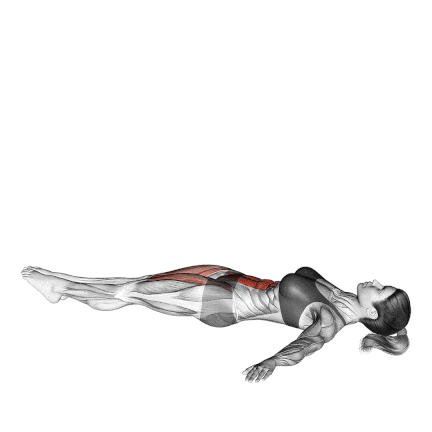
How To Do It
- Lie face up on the floor or bench with your entire body straight and your hands at your sides to stabilise your torso.
- Keep your lower back pressed against the bench or mat.
- Hold your legs a few inches off the floor.
- Raise your legs up toward the ceiling until they are just short of perpendicular to the floor.
- Slowly lower your legs back to the starting position.
- Beginners can start with bent knees or reduce the range of motion.
2. Plank
Unlike exercises like crunches that involve moving the spine (flexion), the Plank is primarily an anti-extension exercise that helps develop core strength and stability.
This helps strengthen your core and also works your shoulders, arms, and glutes. It is also an effective prevention method against back pain.
The plank exercise has many variations, including the forearm plank, high plank, side plank, and reverse plank.
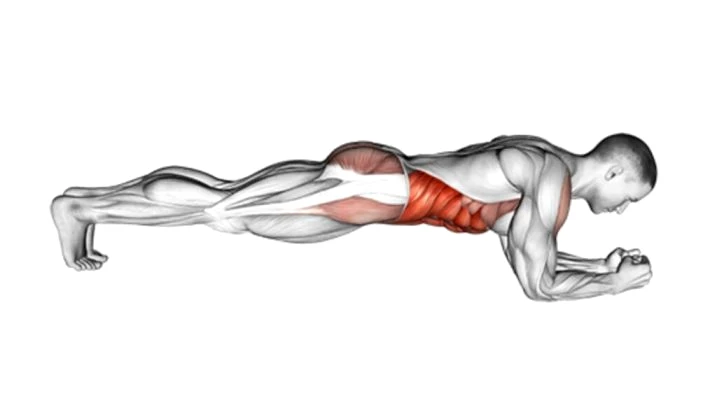
How To Do It
- Start by lying face down on a mat. Place your forearms on the floor with your elbows positioned directly underneath your shoulders. Your palms can be flat on the floor or clasped together.
- Your body should form a straight line from your shoulders to your ankles. Do not let your lower back sag or your butt rise.
- Brace your core by contracting your abs like you were about to be punched in the gut.
- Hold this position for a set amount of time.
- Then do 3-4 more sets.
3. Side Plank
The side plank is one of the best core exercises for strengthening the oblique, abs, and glute muscles.
You will hold your body on your side in a straight position, supported only by one arm and the side of one foot.
If you’re a beginner to planking, you should master the basic forearm plank before moving on to the side plank variation.

How To Do It
- Get in a side plank position by lying on your right side on the floor, with your left foot on top of your right foot and your left arm on top of your left side.
- Raise your body by placing your right forearm flat on the floor, perpendicular to your torso.
- Lift your torso until your right upper arm is straight underneath you. Avoid letting your hips sag during the exercise
- Your elbow is bent 90 degrees, and your forearm is flat on the floor.
- Form a straight line from your head to your heels.
- Hold for 30–60 seconds, then switch sides.
Know More: 100+ Ways To Lose Weight (Proven Techniques)
4. Dead Bug
Compared to abdominal crunches, dead bug exercises showed superior results in improving core strength, endurance, and flexibility in young adults (Ikele et al., 2020).
The Dead Bug teaches your body a fundamental principle of core function: how to move your limbs independently while keeping your spine stable and protected.
This concept, known as lumbo-pelvic stability and anti-extension (resisting the urge to arch your lower back), is vital for preventing injury, improving posture, and transferring force effectively in almost every
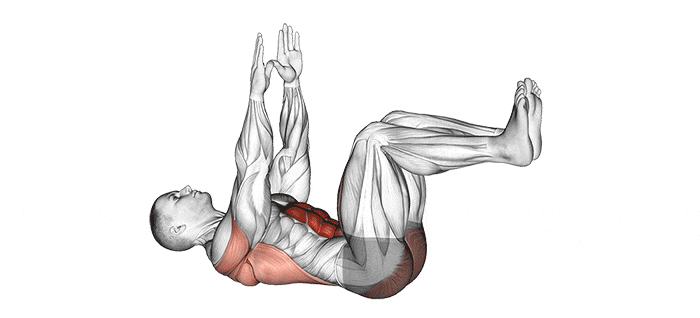
How To Do It
- Lie flat on your back on a comfortable mat. Extend your arms straight up towards the ceiling, directly over your shoulders.
- Bend your knees and hips to 90 degrees, bringing your shins parallel to the floor (the “tabletop” position).
- Slowly lower your right arm straight towards the floor behind your head while extending your left leg straight out, lowering the heel towards the floor.
- Move only as far as you can maintain that lower back contact and core brace. Don’t let your back arch!
- Repeat this movement, this time lowering your left arm and extending your right leg.
- Continue alternating sides in a slow, controlled rhythm for the desired number of repetitions.
5. Twisting Sit Up
The decline twisting sit-up is an abs and oblique exercise made to strengthen your core and build muscle.
It’s a great exercise for intermediate to advanced lifters because it’s moderately challenging but very effective for its intended purpose.
If you are a beginner, doing sit-ups on a flat bench may be easier.
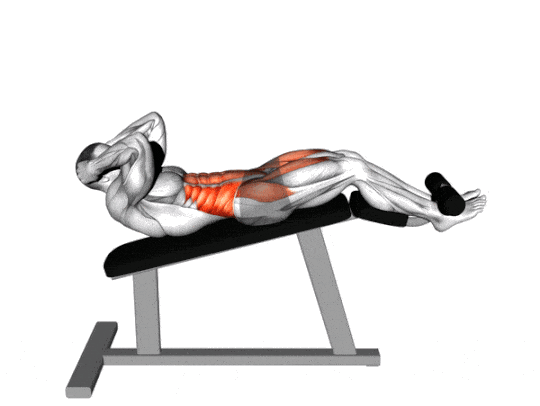
How To Do It
- Sit on the decline bench, hook your feet under the pad, lean back, and position your hands behind your head.
- As you sit up, twist your torso, directing your right elbow toward your left knee. Keep your neck in a neutral position.
- Reverse the motion and lower your torso back to the starting position.
- During the next repetition, direct your left elbow toward your right knee.
- Keep repeating and alternating the side to which you twist your waist.
Related Post: Best Abs And Oblique Exercises With Weighted Bench To Build Strong Core
6. Abs wheel rollout
The wheel rollout exercise is one of the more advanced core exercises. To prepare for it, you can start with the plank and then progress to the wheel rollout when you are ready.
It is considered to be a great move to assist the development of aesthetic abs and strong core muscles. It is one of my favourite workouts.
They’re also an excellent conditioning exercise for both male and female athletes.
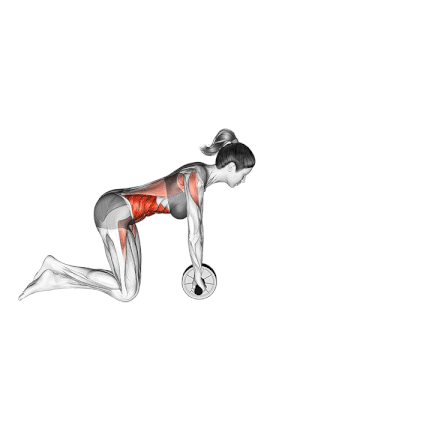
How To Do It
- Kneel on a comfortable mat (you may want extra padding under your knees).
- Place the ab wheel on the floor directly in front of you, gripping the handles firmly with both hands, shoulder-width apart.
- Your hands should start directly under your shoulders.
- Allow the abs wheel to roll forward as far as possible with your knees and toes touching the floor. Keep good posture; don’t sag or arch your lower back.
- The goal is to be as flat as possible, with your torso and upper legs parallel to the floor and hovering just a couple of inches above it.
- Then, reverse the motion to pull the abs wheel back toward your knees until your body is upright again.
7. Barbell rollout
It is one of the advanced core exercises for men that utilises a barbell instead of an ab roller.
It is best performed with a barbell with rotating collars and is considered more difficult than other ab roller variations.
While some male lifters may find it difficult initially, they will be rewarded with a strong core once they can perform a single rep.
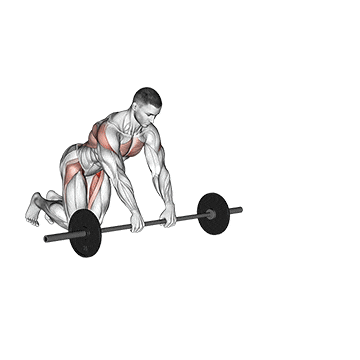
How To Do It
- Kneel on the floor in front of a loaded barbell and grab the barbell with an overhand, shoulder-width group.
- Your arms should be straight and your torso fairly upright in the start position.
- Allow the bar to roll forward as far as possible, with your knees and toes touching the floor.
- Do not allow your hips to sag at any point during the movement.
- The goal is to be as flat as possible, with your torso and upper legs parallel to the floor and hovering a couple of inches above it.
- Then, turn the bar back toward your knees until your body is upright again.
Know More: 7 Gym Machine Abs Workout (Top Exercises To Train Abs And Oblique)
8. Cross-Body Mountain Climber
The mountain climber is an explosive bodyweight exercise that engages multiple core muscles simultaneously.
It helps you improve your balance, agility, coordination, strength, and flexibility with just one exercise.
As you perform the move, your shoulders, arms, and chest stabilize your upper body while your core stabilizes the rest of your body. As the prime mover, your quads and hamstrings get an incredible workout, too.

How To Do It
- Start in the push-up position with your arms completely straight and directly beneath your shoulders.
- Your body should form a straight line from your shoulders to your ankles.
- Lift one foot off the floor, squeeze your abs, and bring your left knee towards your right elbow.
- Return to the starting position and repeat the movement with your opposite leg.
9. Bird Dog
The bird-dog is a bodyweight floor exercise that strengthens the core, specifically the abs, obliques, and lower back.
Several other muscles, including the shoulder, glutes, and thighs, are also addressed.
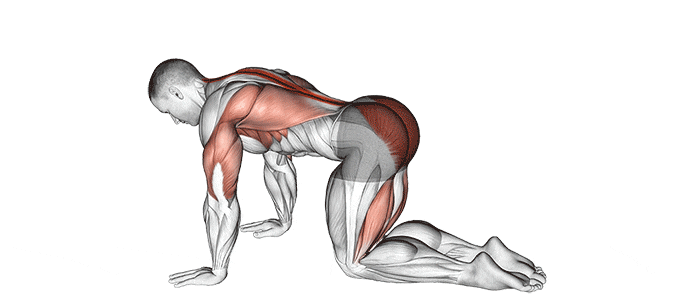
How To Do It
- Get on your knees and place your hands on the floor in front of your body at shoulder width.
- Keep your spine neutral, contract your abs, and lift one hand and the opposite knee slightly off the floor.
- Now extend your arm and leg all the way out. Try to form a straight line from your hand to your foot.
- Hold this position for about 10 seconds and then return to the starting position.
- Repeat the exercise with the other side. Repeat the exercise alternately.
10. V-Up
The V-Up is a full-body move that works your core, legs, back, and shoulders. It also simultaneously works the upper and lower abs muscles.
Hold a weight plate or medicine ball in your hands and wear ankle weights while performing the standard V-up to make it more difficult.
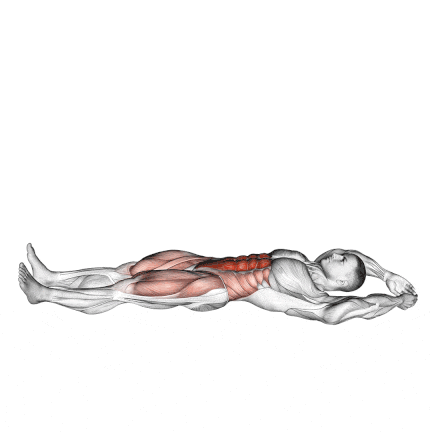
How To Do It
- Lie down on the floor on your back, arms extended straight back behind your head. Your legs should also be extended.
- Exhale and bend at your waist while raising your legs and arms to meet in a jackknife movement.
- Try to hold the contracted position.
- Lower your arms and legs back to the starting position.
- Keep the movement slow and controlled.
11. Superman
Superman is one of the best core exercises for men that you can do at home. It strengthens your lower and upper back muscles, as well as your glutes and hamstrings.
If done regularly, it may help relieve back pain that is related to weak core and back muscles.
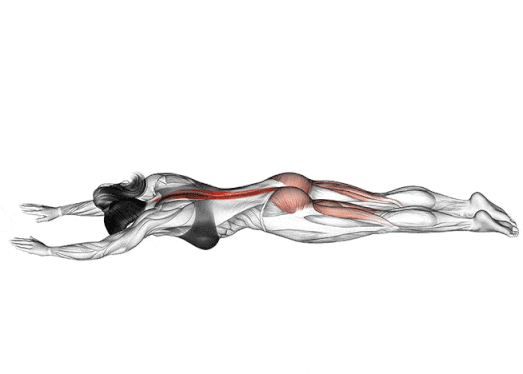
How To Do It
- Lie down with your stomach flat on the ground. Extend your arms in front of you, with your palms down.
- Lift your head, raise your arms and your chest off the ground as far as possible.
- Bend your legs and lift your thighs off the ground as much as possible. (Try to make a big “U” with your back.)
- At this point, you should feel your back muscles, glutes, and hamstrings tighten.
- Try holding for only five or 10 seconds your first time, and work up to 30 seconds in future workouts.
12. Flat bench hyperextension
Flat Bench Hyperextension exercise directly hits the erector spinae muscles, building a strong back.
To make it difficult, you can also hold a plate to your chest or behind the head for additional resistance.
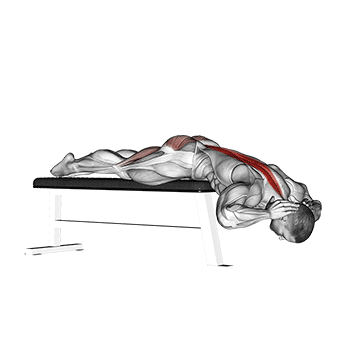
How To Do It
- Lie face down on a flat bench with your torso extending off the end. Hook your heels under the bench to prevent yourself from falling forward.
- Place your hands on your chest (or behind your neck) and bend down through your waist.
- Return to the start position, but avoid extending beyond the body level.
- Do the desired number of reps and sets.
13. Good Morning Exercise
When done in perfect form, the good morning can be a great move for improving your back health.
During this move, the erector spinae muscles work isometrically to keep the spine in an extended position, while the hamstrings and gluteus maximus muscles work isotonically to perform hip extension.
Start with a lightweight or with a stick and gradually add more weight.
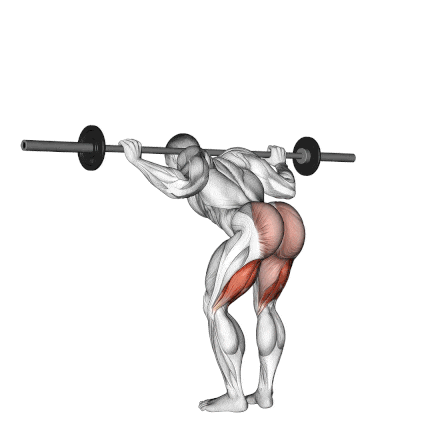
How To Do It
- Stand holding a Stick on the back of your shoulders, grasping the Stick at each side.
- You can also perform the exercise as you did with the bodyweight version.
- Keep your knees slightly bent and your back and neck neutral. Inhale as you lower your torso until it is close to or fully horizontal.
- Exhale as you raise your torso back up to the starting position by extending your hips.
- It is recommended that the lifter avoid rounding (flexing) or rotation (twisting) at any point during the movement.
14. Hip Bridge
The hip bridge, or the glute bridge, is a lower-body exercise that strengthens the glutes, quads, hamstrings, lower back muscles, and other core muscles.
Try a single-leg bridge or add resistance with a weighted plate or band to increase the difficulty.
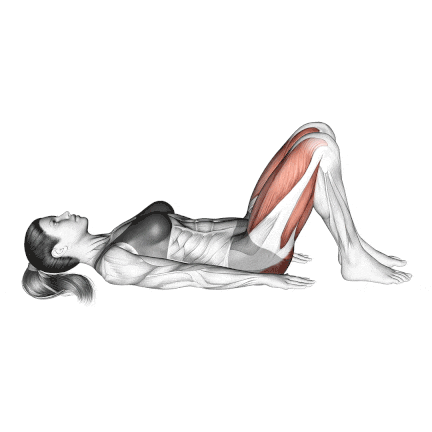
How To Do It
- Lie on your back with your knees bent, feet flat on the floor, and arms by your sides.
- Your feet should be hip-width apart.
- Lift your hips off the ground until your knees and shoulders form a straight line.
- Make sure you squeeze your glutes hard and keep your abs drawn in.
- Hold the bridge position for a few seconds before slowly lowering your hips back to the starting position.
15. Pallof Press
While this core exercise is popular among men, it is also quite difficult to do.
It is a full-body exercise that can increase overall stability and activate many large muscle groups in the body.
The beauty of the Pallof press is that it challenges and strengthens the stabilization action of your abs and obliques.
When you do this exercise, your entire core is forced to engage to resist the rotation of your spine.
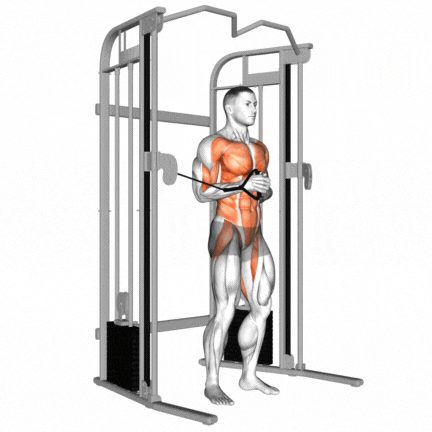
How To Do It
- Grasp the handle with the hand nearest the pulley, and place your free hand over the hand holding the handle.
- Engage your core and press the handle out with both hands, extending your arms in front of your chest.
- Hold this position for 5-10 seconds, resisting the cable’s pull and not letting your torso rotate towards the machine.
- Then, bring the handle back into your chest.
- Repeat the exercise on your opposite side.
16. Cable Wood Chop
Cable wood chop is great for strengthening the oblique and improving the twisting movement pattern of your torso.
You can do wood chops with a dumbbell, but the cable provides a preferable constant tension. This exercise can be incorporated into a core-strengthening or total-body workout.
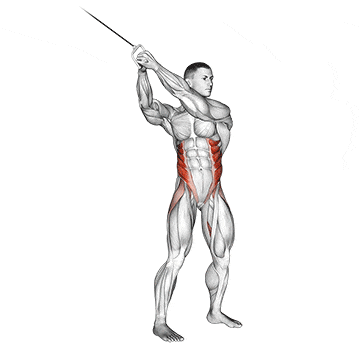
How To Do It
- Attach a handle to the top of the cable pulley. Grasp the handle with both hands.
- Stand next to the machine with your feet shoulder-width apart.
- Hold for a count of two. Then, slowly reverse the movement to return to the starting position.
- Keep your arms straight and pull the handle diagonally downward until your torso faces away from the pulley. Keep your hands knee height.
- Stop and hold the handle for a few seconds halfway through some reps, thus forcing your body to resist the twisting force.
17. Lying Bent-Knee Twist
This exercise can act as a stretch, but the main purpose is to stabilize your core and strengthen your obliques.
The weighted version of the lying bent-knee oblique twist can be done with a ball between your legs.
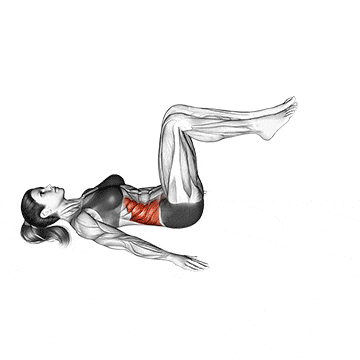
How To Do It
- Lie on your back on the floor or mat with arms extended out to the sides to keep your body stable during the exercise.
- Raise and bend legs at a 90-degree angle, so thighs and lower legs are vertical.
- Keeping your shoulders in contact with the floor, slowly lower your legs to one side until you feel a mild stretch in your lower back.
- Now, rotate your legs all the way to the right. Repeat for the desired number of reps.
18. Dumbbell Side Bend
In addition to strengthening the obliques, the dumbbell side bend is effective at improving spinal mobility and helping to develop a strong core.
It is a simple core exercise that you can practice at home. If you are a beginner, you can practice the movement with your bodyweight alone.
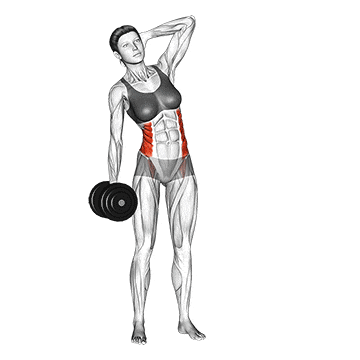
How To Do It
- Stand with your feet shoulder-width apart while holding a dumbbell with a neutral grip in your right hand with your arm hanging at your side.
- Bend sideways at the waist to the left as low as possible, using your oblique muscles to pull your torso down.
- Hold for a second and return to the starting position.
- Complete the desired number of reps and repeat on the other side.
- Keep the dumbbell close to your side, your elbow very slightly bent, and your hips still.
- To work the oblique muscle, perform these exercises slowly and steadily.
19. Stability Ball Tuck
Stability Ball Tuck is a core stabilising exercise that improves balance, strength, and flexibility throughout the hip and abdominal region.
It is one of those core exercises that looks like it is fun to perform.
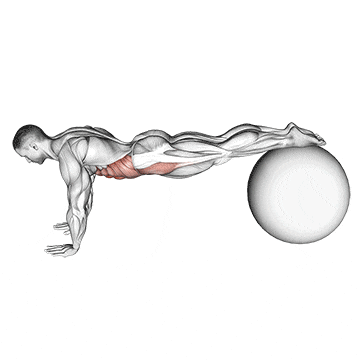
How To Do It
- Lie on the floor in a push-up position with your feet resting on top of an exercise ball.
- Tuck your knees in toward your chest while rolling the ball forward.
- Hold the tucked position briefly, then return to the starting position by extending your legs.
- Repeat for the desired number of reps.
20. Side Plank Dips
If you want to improve your core and arm strength, side plank dips are an excellent addition to your routine. This exercise effectively targets your core muscles, particularly your obliques.
Planks work your obliques and trim your waistline. The extra dip will improve your muscle control and posture.
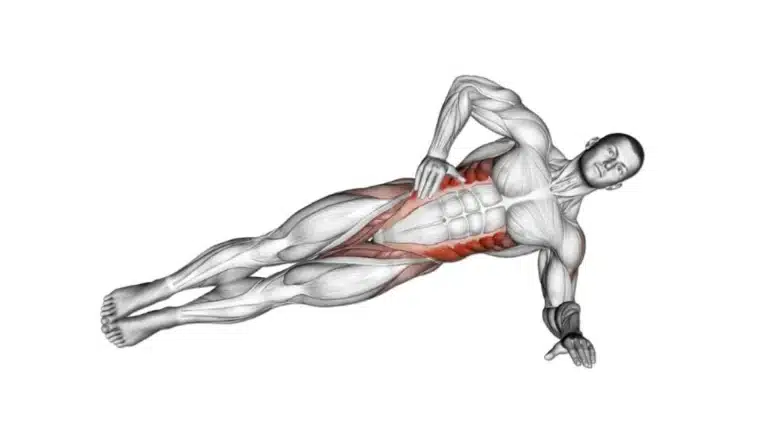
How To Do It
- Lie on the floor on your left side with your elbow directly beneath your shoulder and legs stacked.
- Place your free hand on your hip. To increase comfort and stability, place an exercise mat under your arms.
- Straighten your body and legs. Your feet should be together, and your hip should be resting on the floor.
- Brace your abs and lift your hips off the floor until you’re balancing on your forearm and feet and your body forms a diagonal line.
- Slowly bring your hips back to the floor. Repeat on your right side.
21. Dumbbell Farmers Walk
It is a great exercise for building your core muscles and improving your grip strength.
Farmer walk also improves your overall strength and functional fitness by strengthening your abs, back, glutes, legs, and gait.
It is a strength and conditioning exercise in which you hold a heavy load in each hand while walking.
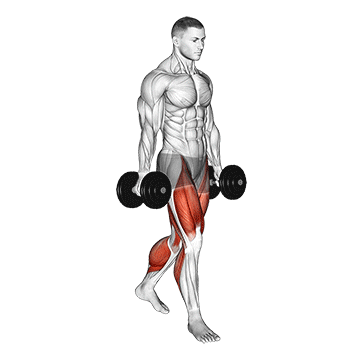
How To Do It
- Select dumbbells that are challenging but allow you to maintain proper form
- Hold the dumbbells at your side with a firm grip.
- Stand tall, and keep your shoulders, back, and core tight.
- Take small steps and walk forward at an even pace with your eyes focused straight ahead of you.
- Walk for a specified duration, such as 30–60 seconds, or a predetermined distance.
- Take even, controlled steps to maintain balance and stability.
22. Kettlebell Swing
Kettlebell swings are based on the deadlift movement pattern and hit almost every muscle in the body, especially those of the posterior chain. This results in a stronger back, hamstrings, calves, and hips.
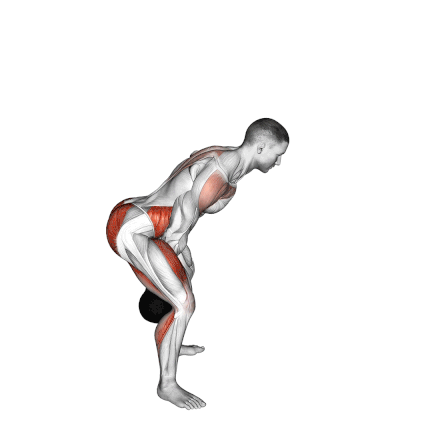
How To Do It
- Place your feet slightly wider than shoulder-width apart.
- Stand in a spine-neutral position with your arms in front of your body. Hold the kettlebell with both hands, palms down.
- With your knees bent slightly and hips thrust back, adopt a squat-like position, but refrain from going as far down as possible.
- Drive your hips forward while swinging the kettlebell forward and up to shoulder height. You should feel your hips and glutes engaging in this motion.
- The kettlebell should then be lowered back between your legs, and the swinging motion should be repeated for 12–15 repetitions.
23. Russian Twist
It engages your core and strengthens your abs as well as your lower back.
That makes them one of the best abs exercises for men, but you have to do many of them to feel the burn.
A more advanced way of doing the Russian twist is to raise your feet off the floor and use a weighted twist.
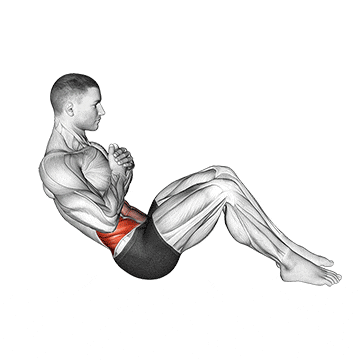
How To Do It
- Lie down with your knees bent and feet flat on the ground.
- Elevate your upper body to create a V shape with your thighs.
- Begin to twist side to side while maintaining balance on your buttocks, keeping constant tension on the abs.
- Repeat this movement until the set is complete.
24. Turkish Get Up
The Turkish Get-Up is a complex, multistep exercise that involves transitioning from lying on the floor to standing up, all while holding a weight overhead.
Traditionally performed with a kettlebell, it can also be done with a dumbbell. This exercise is known for working multiple muscle groups and joints, giving a full-body workout.
It improves shoulder strength, flexibility, and core performance as well.
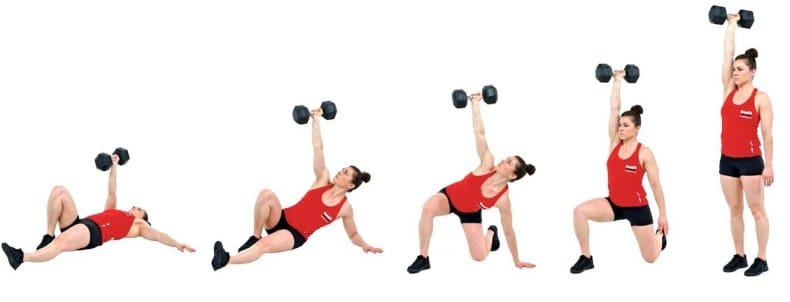
How To Do It
- Lie on your back on the floor and hold a dumbbell in one hand with your arm fully extended above your chest.
- Bend the knee of the same side to a 90-degree angle. Keep your opposite leg straight, and place it 5–10 degrees away from the midline of your body.
- Start by lifting the dumbbell to the sky, and crunching onto your opposite elbow.
- Keep the elbow of the arm holding the dumbbell locked out.
- Hike your hips in the air and sweep the straight leg underneath the body, stepping back and settling onto your knee.
- Shift the weight away from your hand and onto your knee and front foot as you bring your torso upright.
- Push to a standing position, keeping the dumbbell lifted the entire time. Lower slowly back to the ground.
25. Bicycle Crunch
The bicycle crunch works out your abs, rectus femoris, obliques, and Intercostal.
To make the exercise easier, you can make the angle between your knees smaller, and to make the exercise harder, you can make the angle between your legs larger.
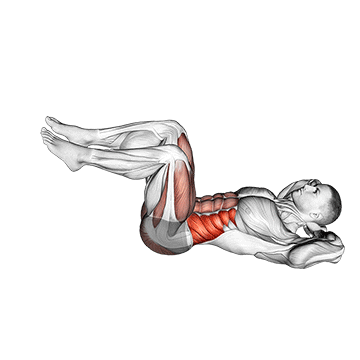
How To Do It
- Lie on the floor with your legs straight and your lower back flat on the floor.
- Place your hands behind your head and raise your feet and upper back slightly off the floor.
- Make sure that you don’t pull your neck with your hands, else you can get a neck strain.
- Slowly start raising your knees at a 45-degree angle.
- Go through a bicycle pedalling motion with your legs as you alternately touch your elbows to the opposite knees, twisting back and forth.
Core Strengthening Workout Plans
The specific number of sets and reps can be adjusted based on your fitness level. This format provides a clear and structured approach to your core workout
Beginner Core Workout Plan
| Exercise | Sets | Reps |
|---|---|---|
| Plank | 2-3 | 20-30 seconds |
| Dead Bug | 3-4 | 8-10 per side |
| Lying Leg Raises | 2 | 8-10 |
| Bird Dog | 2 | 8-10 per side |
Intermediate Core Workout Plan
You can increase the intensity at an intermediate fitness level by adding the overload principle and increasing the difficulty. Utilise slightly harder exercises like sit-ups and Russian twists.
| Exercise | Sets | Reps |
|---|---|---|
| Plank | 3 | 30–45 sec |
| Russian Twists | 3 | 12-15 per side |
| Bicycle Crunches | 3 | 12-15 per side |
| Hip Bridges | 3 | 12-15 |
| Sit-ups | 3 | 10-12 |
Advanced Core Workout Plan
Advanced core training should focus on complex, functional multi-joint movements. To increase the challenge, go for lower reps using added resistance.
| Exercise | Sets | Reps |
|---|---|---|
| Side Plank | 3-4 | 30-60 sec per side |
| Hanging Leg Raises | 3-4 | 10-15 |
| Weighted Russian Twists | 3-4 | 15-20 per side |
| Mountain Climbers | 3-4 | 15-20 per side |
| Turkish Get-Up | 3 | 6-8 per side |
Know More About Your Core Muscles
In casual workout conversations, the words “core” and “abs” are often used interchangeably, but the core is much more complicated than just the six-pack.
In reality, your core is composed of many muscles in the abdomen (rectus abdominus, transverse abdominus, internal and external obliques), hips, back, serratus anterior, butt, and legs.
You need to work all the muscles to build a strong core.
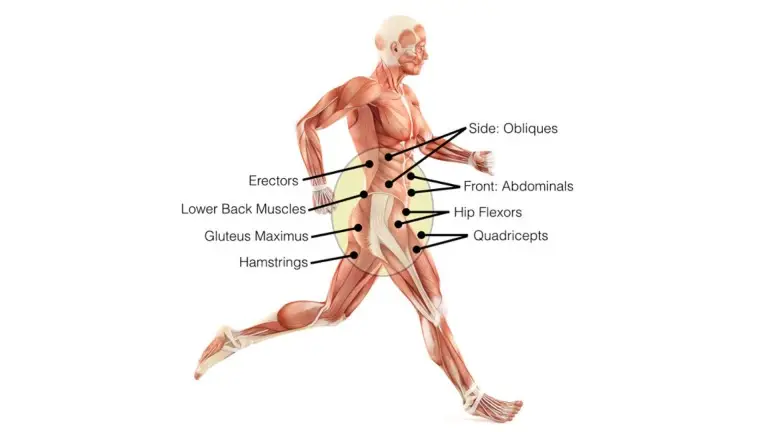
Rectus Abdominis
The rectus abdominis is a paired muscle running vertically down the front of the abdomen. It is commonly referred to as the “six-pack” muscle.
The two rectus abdominis muscles (one on each side) are encased in a sheath of fascia that forms the central dividing line down the middle of the abs.
External Oblique
The largest of the three flat abdominal muscles are located along the sides and in front of the abdomen.
The external oblique pulls the chest down to compress the abdominal area, which is also important in rotating the trunk.
Internal Oblique
It is located along the sides, in front of the abdomen, below the external oblique, and above the transverse abdominis.
When contracted, this muscle is responsible for side bending, bringing the rib cage closer to the hip, and aiding in trunk rotation.
Transversus Abdominis
The deepest part of the abdomen, which lies horizontally across the abdominal wall.
Its primary role is to assist with breathing, especially exhalation from the lungs. It also helps stabilise the spine.
Erector Spinae
Group of three muscles, the iliocostalis, longissimus, and spinalis. Its function is to extend the back and assist with side-to-side rotation.
Hip Flexors
A group of muscles runs from the bottom of your stomach to the top of your thigh on the front of your body. They include the psoas major, iliacus, rectus femoris, pectineus, and sartorius.
The hip flexors are responsible for bringing the legs into flexion and toward the trunk.
Hamstrings
A muscle group starts at the bottom of the pelvis and ends at the lower leg below the knee joint.
The group comprises three muscles: the semitendinosus, the semimembranosus, and the biceps femoris. The hamstrings are responsible for bending and extending the knee.
FAQ
How can a man strengthen his core fast?
The best core strengthening exercises for men. A classic core-strength workout.
- Plank
- Dead Bug
- V-Up
- Side Plank
- Abs Wheel Rollout
- Mountain Climber
- Superman
- Hip Bridge
- Pallof Press
What core exercises should I do every day?
Here are five exercises you can do to strengthen your core.
- Plank
- Side Plank
- Dead Bug
- Mountain Climber
- Hip Bridge
Disclaimer:
The information contained in this article is for educational and informational purposes only and is not intended as health advice. We would ask you to consult a qualified professional or medical expert to gain additional knowledge before consuming any product or performing any exercise.
References
- James Rainville , Carol Hartigan, Eugenio Martinez, Janet Limke, Cristin Jouve, Mark Finno: Exercise as a treatment for chronic low back pain. PMID: 14749199 DOI: 10.1016/s1529-9430(03)00174-8
- A Murtezani, H Hundozi, N Orovcanec, S Sllamniku, T Osmani: A comparison of high-intensity aerobic exercise and passive modalities for the treatment of workers with chronic low back pain: a randomized, controlled trial: PMID: 21602759
- Calatayud J, Casaña J, Martín F, Jakobsen MD, Colado JC, Andersen LL. Progression of core stability exercises based on the extent of muscle activity. Am J Phys Med Rehabil. 2017;96(10):694-6. doi:10.1097/PHM.000000000000071
- Snarr, Ronald L. Esco, Michael R Electromyographical Comparison of Plank Variations Performed With and Without Instability Devices. Journal of Strength and Conditioning Research: November 2014 – Volume 28 – Issue 11 – p 3298-3305
- doi: 10.1519/JSC.0000000000000521
- Szafraniec R, Barańska J, Kuczyński M. Acute effects of core stability exercises on balance control. 3.Acta Bioeng Biomech. 2018;20(4):145-151.
- Hsu, S. L., Oda, H., Shirahata, S., Watanabe, M., & Sasaki, M. (2018). Effects of core strength training on core stability. Journal of physical therapy science, 30(8), 1014–1018. https://doi.org/10.1589/jpts.30.1014

Manish is a NASM-certified fitness and nutrition coach with over 10 years of experience in weight lifting and fat loss fitness coaching. He specializes in gym-based training and has a lot of knowledge about exercise, lifting technique, biomechanics, and more.
Through “Fit Life Regime,” he generously shares the insights he’s gained over a decade in the field. His goal is to equip others with the knowledge to start their own fitness journey.
